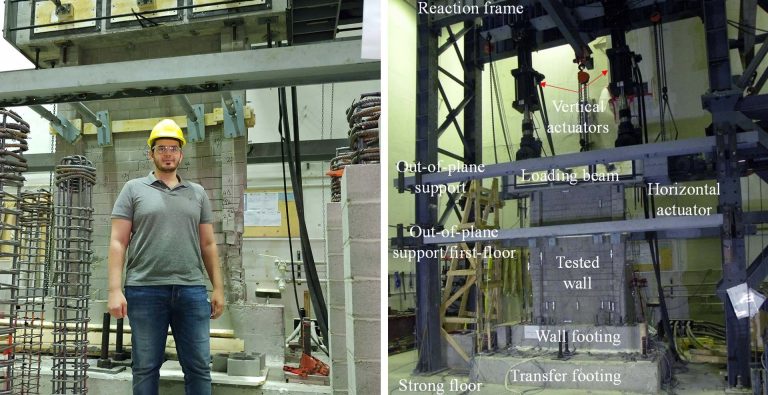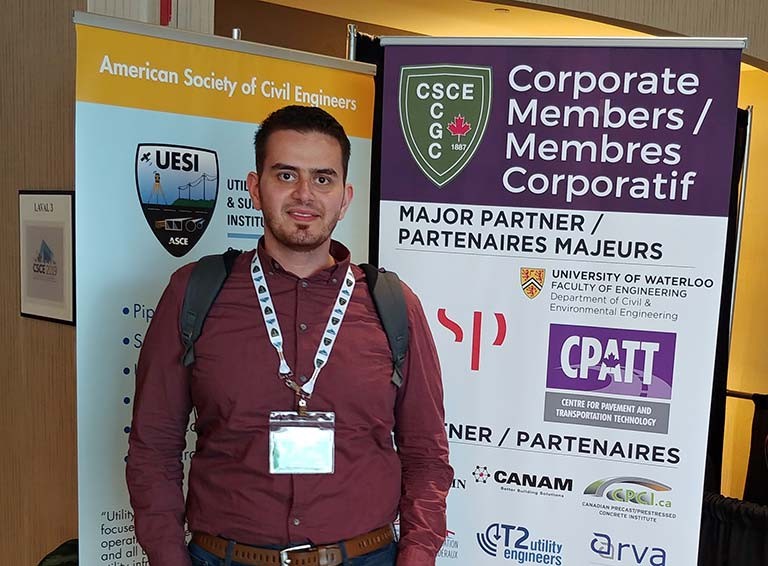Concordia researcher uses advanced modelling software to test buildings for earthquake safety

With seismically active regions in the west and east of Canada, engineers are always looking for ways to improve the safety of dwellings in these areas and beyond.
Nader Aly, PhD candidate in the Department of Building, Civil and Environmental Engineering at Concordia’s Gina Cody School of Engineering and Computer Science, aims to make buildings more resilient and sustainable under extreme loading such as earthquakes. His research centres on the structural performance of masonry components and systems like reinforced concrete.
It is crucial that my research findings have practical applications in the masonry construction industry

How does this specific image relate to your research at Concordia?
Nader Aly: In this image I was presenting part of my research findings at the annual conference of the Canadian Society for Civil Engineering, which took place in Laval, Quebec, last year. My research focuses on enhancing the structural performance of masonry components and systems.
At that conference, I presented some of the testing results of two large-scale reinforced masonry shear walls, which were constructed and tested in the structures laboratory at Concordia, which is part of the Centre for Structural Safety and Resilience(CSSR). The testing rig along with one of the test specimens are shown in the other image (top).
What is the hoped-for result of your project?
NA: My research objective is to come up with resilient and sustainable reinforced masonry structural systems. It is crucial that my research findings have practical applications in the masonry construction industry. This will contribute to the safety and well-being of people and society.
What impact could you see it having on people’s lives?
NA: These structural systems will offer higher resistance to extreme loading, such as earthquakes. Therefore, buildings designed with these systems will offer a more resilient option for developers and a safer option for occupants.
What are some of the major challenges you face in your research?
NA: My research goal is to enhance the competitiveness and performance of masonry buildings. It involves physical testing of large-scale specimens, structural walls and numerical simulations using advanced modelling software.
The main challenges were the limited previous studies concerned with testing masonry components and systems, in addition to the absence of masonry-specific modelling tools. This meant it took more time to overcome the modelling and simulation challenges.
As for the experimental component of my research, there were many challenges involved in sizing the test specimens to fit within the available testing rig dimensions and capacity. Testing these large-scale specimens under simulated earthquake actions also involved many obstacles. My overall concern was to always ensure the practicality and applicability of the research findings.
What first inspired you to study this subject?
NA: My background in earthquake engineering made me realize the importance of designing safe and economical structures. I was inspired by the available structural testing facilities at Concordia.
I realized the potential for performing large-scale testing and the opportunity of enhancing the performance of masonry structural components and systems. However, shaping this research study and performing it would have never been possible without the guidance, motivation and support of my supervisor, Khaled Galal.
What advice would you give interested students to get involved in this line of research?
NA: Research in general involves many challenges, especially when it involves physical testing of large-scale specimens. My advice to interested students is to always be persistent, never give up and stay focused on your objectives. No matter what the challenges are, there is always a solution!
What do you like best about being at Concordia?
NA: Concordia has a great environment and provides perfect facilities for its students. This makes it an ideal place for research, where you can remain focused knowing that the university is fully supporting you. Also, the faculty and staff in the Department of Building, Civil and Environmental Engineering are very friendly and always willing to help and support students.
Nader Aly’s research is supported by the Natural Sciences and Engineering Research Council of Canada, l’Association des entrepreneurs en maçonnerie du Québec (AEMQ), the Canadian Concrete Masonry Producers Association (CCMPA) and the Canadian Masonry Design Centre.
Find out more about Concordia’s Department of Building, Civil and Environmental Engineering.


